
If you’ve followed my blog for awhile, you’re probably aware that I have an appreciation for Stowa watches. I’ve reviewed their Partitio in the past, and generally liked what I saw. Today, I’ll be looking at another Stowa, their Flieger Classic 36.

These watches are individually serialized, so each one is truly unique. They’re designed to be a great gift, since they come with custom engravings that you can configure through Stowa’s online tool. Since we’re right on top of the holidays, it seemed like the perfect time to review the Flieger Classic 36. Let’s take a closer look!
ETA 2824-2 Movement
To anyone with an appreciation for horology, the ETA 2824-2 is a familiar sight. This is a self-winding, hacking automatic movement with a 38-hour power reserve.

That’s more than enough to set it on the shelf for a day without having to wind it up. There are plenty of copycats on the market, and some of them are quite good. But there’s something about wearing the original on your wrist that just feels right. The accuracy on this movement is about +/- 12 to 30 seconds a day. If you’re towards the high end, it can be worthwhile taking it to a professional to have it adjusted.

The ETA 2824-2 was based on the Caliber 1247, which was one of the first widely-adopted automatic movements to be developed. The major breakthrough with the 1247 – or more specifically, it’s predecessor, the 1237 – was that the oscillating weight was mounted on five ball bearings. These bearings keep the movement smooth, and help prevent premature wear and tear.
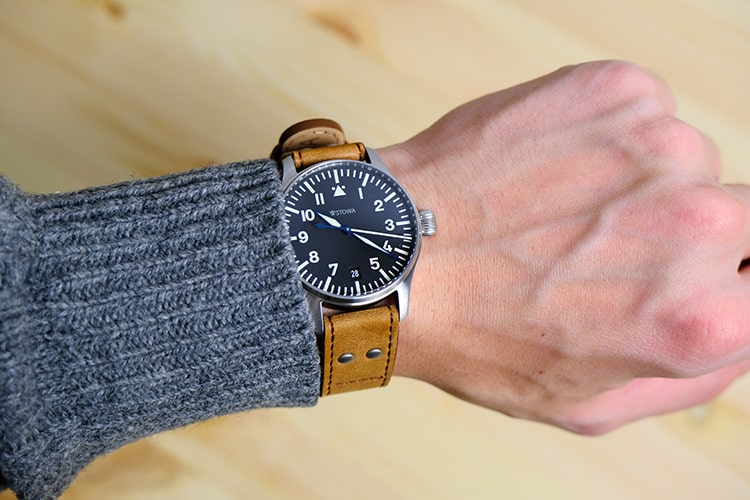
Before the use of ball bearings, automatic movements weren’t very reliable, and wore out quickly. Surprisingly, this five-ball bearing design is still in use on the 2824-2. Why improve on perfection?
Numerals and Complications
The Flieger Classic 36 has a matte black dial with understated markings that leave a clean, classy impression. Individual hashes mark off each minute, with larger hashes at the five-minute marks.
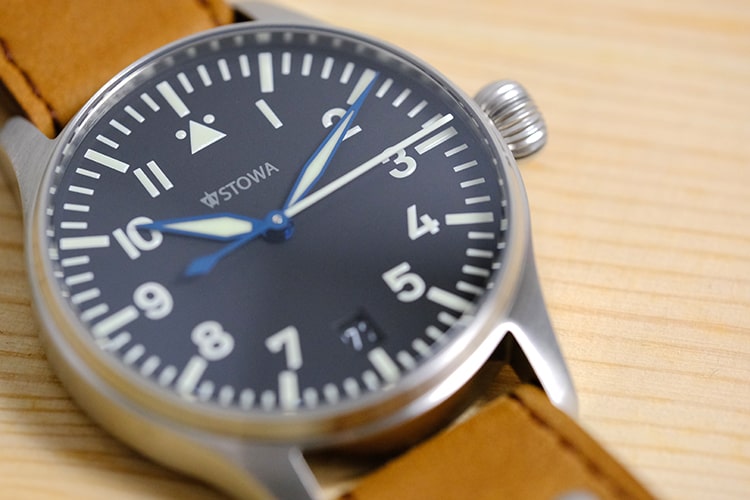
At all positions except 12 and 6 o’clock, you’ll find matching white numerals. The font is relatively plain, with a lot of straight lines and no serifs or other decorations. The 12 o’clock position is marked by a triangle, with a small, faint gray Stowa logo underneath.
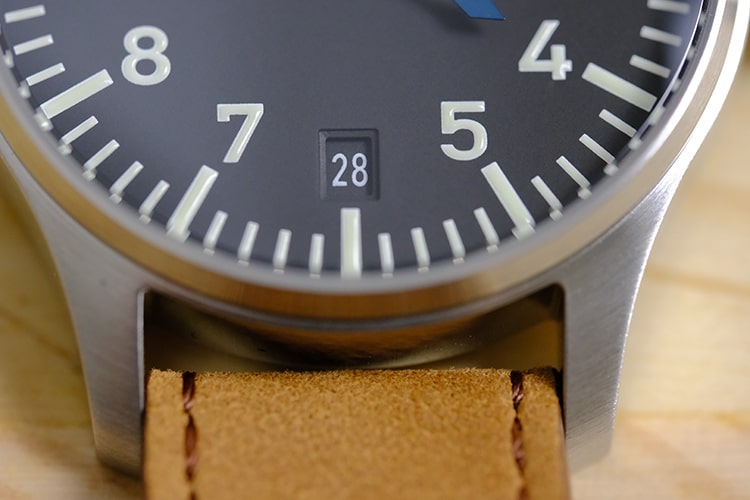
The date complication is fairly unusual. Instead of being located at the 3 o’clock position, it sits where the 6 o’clock numeral would otherwise be positioned.

The minute and hour hands are fashioned from blue steel, with a bright aquamarine finish that immediately catches the eye.
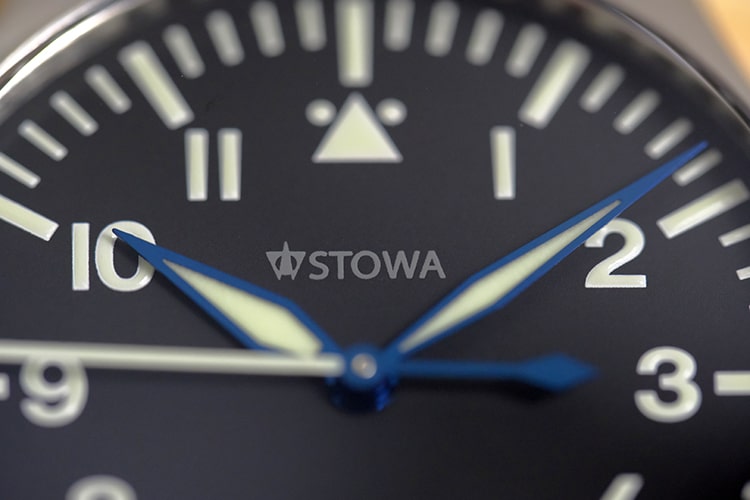
The centers of the hands are white, and are painted with a Superluminova finish, as are the numerals and hashes. The second hand is pure white, with a blue counterweight on the back end that matches the finish on the larger hands.
Watch Case and Crystal
The watch case is constructed from stainless steel, with a diameter of 36mm. At only 10.2mm thick, the Flieger Classic 36 is large enough to have some wrist presence, but small enough that it feels light while you’re wearing it. The lugs are fairly tall, with a lug-to-lug measurement of 44.6mm. The way the band attaches leaves an attractive bit of negative space between the end of the band and the outer edge of the case.

The back of the case has an open-back design, with the top half completely open behind the back crystal. The bottom half consists of a stainless steel plate, where you’ll find the serial number and other information. Despite this, it’s still water-resistant to 50 meters, so it’s just fine for taking in the shower or going for a swim.
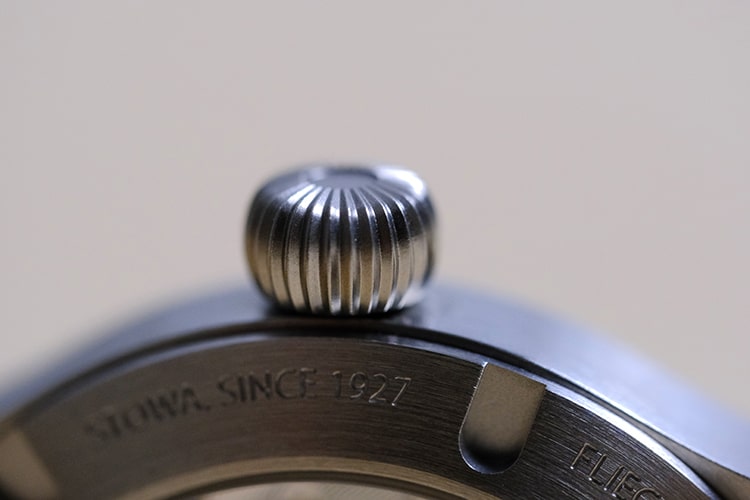
The front crystal on the Flieger Classic 36 is almost totally flush with the top of the case, with only the slightest bevel on the edge. Both the front and rear crystals are scratch-resistant, glare-resistant sapphire.

Unlike some crystals with large bezels or domes, the Classic 36 is designed not to attract any attention. Everything about this watch is minimalist, understated, and clean.
Leather Strap
The strap on the Flieger Classic 36 is 18mm in width, and is constructed from attractive tanned leather. It’s fairly slender, but it’s thick for the width, and it’s very sturdy.
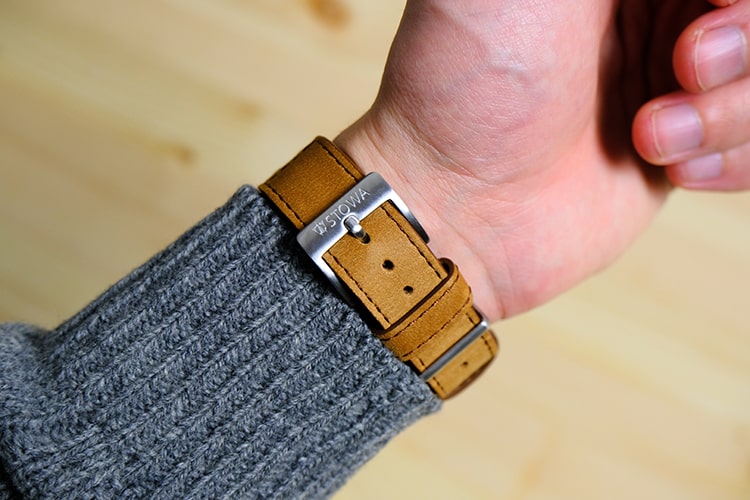
It’s stitched for reinforcement, although the threads more or less match the leather, so they’re discreet. The buckle is thick and sturdy, constructed from an attractive stainless steel that matches the case exactly.
The Backstory
The Flieger Classic 36 is a variant on Stowa’s classic pilot watches, which were originally produced in 1927. Development petered off during World War II, since there were other, more pressing concerns on most people’s minds at the time. The last of the original units were produced in 1942.

In 1997, Stowa began re-releasing their pilot watches. In 2010 and 2012, additional variants were re-released, including the Classic 36.
To have a look at the Stowa’s full range of watches visit their official website here.
Hi Matthew,
Thank you for this review. I am interested in this 36mm but that size makes me a little bit nervous. I wish it was 38mm with 20mm lugs. I think the 40mm would be too large for my tastes. This watch looks great on your wrist in the above photo. What size wrist?
Thank you,
Adam
Hey Adam, I’m glad you like the review. I have a 6.5 inch wrist, and this 36mm is my go to size. The lug length feels perfect for me.
Hi Matthew,
Thank you for the reply. Same sized wrist here. In the last couple years my watches in rotation have been getting much smaller. I put on my Sinn 104 today and it looked giant. I guess I should move it. Too bad it’s not 38mm.
I see one of these Stowa Classic 36 in my future.
Hi.
Let me draw your attention to a mistake: if you look at the inscription on the rotor you see “B-Uhr”. This rotor therefore belongs to the watches of the “B” series while all the pictures you have on your page are of watches of the “A” series.
Sincerely, Eugen
Hi Eugen, all the pictures in this review are of the same watch
Actually you’re the one who has made a mistake, B-Uhr refers to the shorthand for “observation watch” in German and has nothing to do with what Type dial is being used.
Hi Matthew.
I’m sorry I made a mistake. I have confused two terms which are both identified by the letter “B” but which refer to two different things:
1) The term “B-Uhr” (in German, and written on the rotor of your watch above) refers to = Deck clock (also >observation clock or “B-Uhr”, since the German term is “Beobachtungsuhr) is another name for the observation clock, which stems from the fact that these clocks were used on ships for observation purposes at various points on the deck, unlike the fixed ship’s chronometer, which was stationed in the captain’s cabin. This is inscribed on the rotor of your watch.
2) The terme “Type B” = The variant of pilot’s watches which have on the dial a smaller circle showing the hour indications and on the outer circle the minutes. Your watch is “Type A” since on the dial there is only one outer circle showing both the hours and the minutes. “Type C” being a chronograph. These terms (Type A or B or C) are never inscribed on a watch.
On that occasion, I learned something. Please excuse me. Yours sincerely, Eugen